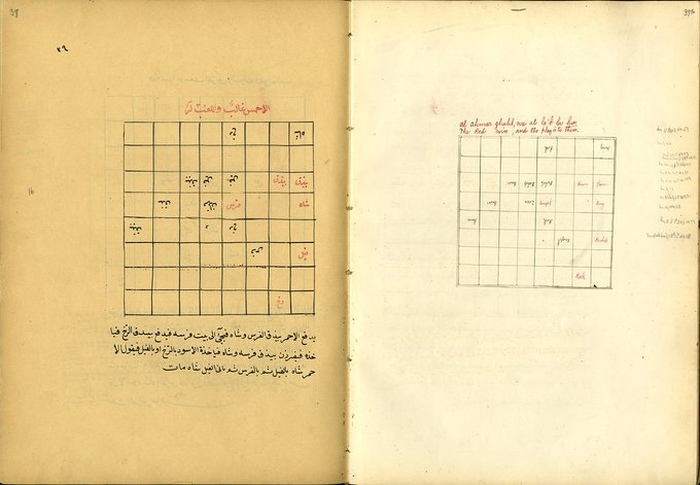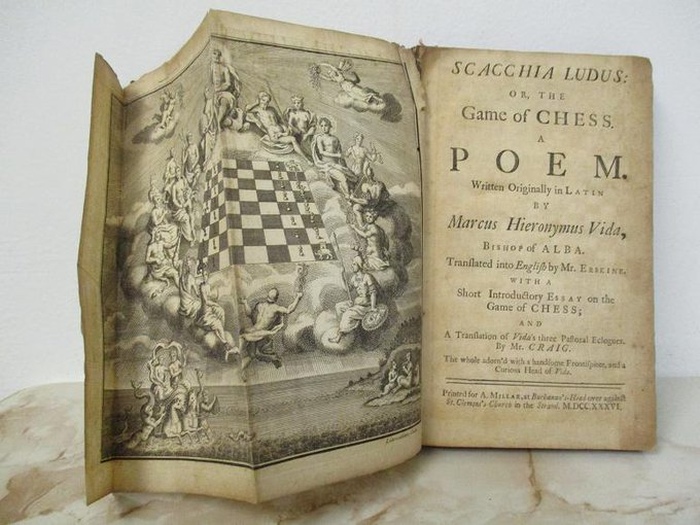A few days ago, on the occasion of World Book Day on April 23, we devoted a series of social media posts to chess books and their history, that we have decided to compile here.
It has often been said that there have been more books published on chess than all other sports combined. While this statement should be taken with a grain of salt, a fair estimation is that more than 100,000 chess books have been published since the invention of the print.A few days ago, on the occasion of World Book Day on April 23, we devoted a series of social media posts to chess books and their history, that we have decided to compile here.
It has often been said that there have been more books published on chess than all other sports combined. While this statement should be taken with a grain of salt, a fair estimation is that more than 100,000 chess books have been published since the invention of the print.
 Some of the problems contained in the Kitab ash-shatranj
Some of the problems contained in the Kitab ash-shatranj
The first comprehensive book dealing with chess was the Kitab ash-shatranj (Book of the chess), written in Arabic by Al-Adli ar Rumi around the year 850. The original is long lost, but we know of it through later works that preserved some of its texts and chess problems.The first comprehensive book dealing with chess was the Kitab ash-shatranj (Book of the chess), written in Arabic by Al-Adli ar Rumi around the year 850. The original is long lost, but we know of it through later works that preserved some of its texts and chess problems.
 “Book of the Games”, dated 1283″Book of the Games”, dated 1283
“Book of the Games”, dated 1283″Book of the Games”, dated 1283
The “Book of Games” commissioned by Spanish King Alfonso X, contains the earliest European treatise on chess as well as being the oldest document on European table games. It was finished in 1283, and it is kept in El Escorial, a few kilometres north of Madrid.The “Book of Games” commissioned by Spanish King Alfonso X, contains the earliest European treatise on chess as well as being the oldest document on European table games. It was finished in 1283, and it is kept in El Escorial, a few kilometres north of Madrid.
 “Repetition of Love and the Art of Playing Chess with 150 Games”, by Luis Ramírez de Lucena
“Repetition of Love and the Art of Playing Chess with 150 Games”, by Luis Ramírez de Lucena
Not far from El Escorial, in the bustling university city of Salamanca, a copy of Lucena’s book is kept at the Historical Library of the University. Published in 1497, this is the oldest surviving document on “modern chess”, with the game being played with the current rules, exactly as we know it today. There is little doubt that this book is basically a copy of a previous one, published in Valencia some years before by a certain Francesch Vicent, but this original went lost long ago, never to be found again, despite the efforts of many historians – and wealthy collectors.
With the invention of the mechanical print in Europe, multiple copies of a book would be produced. With that, the chances of a work simply vanishing like Vincent’s incunable were greatly reduced. A curious fact is that it was often the case that whenever a new printer was built, chess books were often among the first ones to come out, along with the bible. In fact, the second book ever printed in English language was a chess book!Not far from El Escorial, in the bustling university city of Salamanca, a copy of Lucena’s book is kept at the Historical Library of the University. Published in 1497, this is the oldest surviving document on “modern chess”, with the game being played with the current rules, exactly as we know it today. There is little doubt that this book is basically a copy of a previous one, published in Valencia some years before by a certain Francesch Vicent, but this original went lost long ago, never to be found again, despite the efforts of many historians – and wealthy collectors.
With the invention of the mechanical print in Europe, multiple copies of a book would be produced. With that, the chances of a work simply vanishing like Vincent’s incunable were greatly reduced. A curious fact is that it was often the case that whenever a new printer was built, chess books were often among the first ones to come out, along with the bible. In fact, the second book ever printed in English language was a chess book!
 “The Game of Chess”, circa 1483
“The Game of Chess”, circa 1483
“The Game of Chess” was the second* book ever printed in the English language, in 1483, by William Caxton (1422 – 1491), an English merchant, diplomat, and writer. Caxton is thought to be the first person to introduce a printing press into England, in 1476. That made him the first English retailer of printed books.
“The Game of Chess” was Caxton’s own translation of “De Ludo Scachorum”, originally written in Italian around 1280, that spread all over Europe through a French translation made in 1347. Extremely popular, two early English versions were of poor quality and hadn’t succeeded. But Caxton’s translation, which he created from several French sources, became the authoritative English version.
This work is not exactly a chess book, but a series of sermons metaphorically using chess to depict the relationships between a King and the various estates of his Kingdom. However, the author decided to include the complete rules of chess to make the metaphor accessible to all readers.
*[For those wondering, the first book in English ever printed, was “The Recuyell of the Historyes” of Troye, also printed by Claxton from a French translation, and also in 1474. Caxton printed almost 100 books, and of these 20 were translations from French or Dutch into English.]

